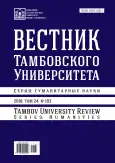Vol 24, No 183 (2019)
- Year: 2019
- Published: 15.12.2019
- Articles: 28
- URL: https://journal-vniispk.ru/1810-0201/issue/view/19855
Full Issue
PEDAGOGY OF HIGHER EDUCATION
Project activities: analysis of theoretical approaches in the context of psychological and pedagogical research
Abstract
 7-13
7-13


THEORY AND METHODS OF FOREIGN LANGUAGE TEACHING
Formation of foreign language grammatical competence among high school students
Abstract
 14-23
14-23


Translation features of the Chinese military slang
Abstract
 24-34
24-34


Subject content of teaching English language to students of “Technology of production and processing of agricultural products” programme
Abstract
 35-44
35-44


ТЕОРИЯ И МЕТОДИКА ОБУЧЕНИЯ РУССКОМУ ЯЗЫКУ
Peculiarities of teaching students foreigners the basics of oratory
Abstract
 45-51
45-51


QUESTIONS OF SOCIAL PEDAGOGY AND SOCIAL WORK
Social and pedagogical aspects of the formation of student potential as a personnel reserve
Abstract
 52-59
52-59


General characteristics of the professional training of the social work in Vietnam
Abstract
 60-69
60-69


Social experience of personality: an interdisciplinary categorical analysis
Abstract
 70-84
70-84


THEORY AND METHODS OF PHYSICAL TRAINING TEACHING
On the issue of highly skilled athletes physiological adaptation
Abstract
 85-90
85-90


Possibilities design and implementation of quality improvement of self-realization and individual cooperation in the sports and educational environment
Abstract
 91-101
91-101


Development features of moving abilities of 8–11 grade school students
Abstract
 102-111
102-111


Elements usage of jazz gymnastics in the choreographic training of 12–14 years old “rhythmic” gymnasts
Abstract
 112-117
112-117


Methodology implementation features for the development of coordination abilities on the basis of an integrated approach among children with mental retardation
Abstract
 118-127
118-127


ПЕДАГОГИКА ДОШКОЛЬНОГО И ШКОЛЬНОГО ОБРАЗОВАНИЯ
Model of social intelligence development in senior preschoolers in the process of joint activity
Abstract
 128-136
128-136


Innovative activities in modern school: realization experience
Abstract
 137-147
137-147


Method of projects in contemporary primary school
Abstract
 148-155
148-155


On the formation of value attitude to the Russian language study at school
Abstract
 156-164
156-164


NATIONAL HISTORY
Materials on the history of military temple construction in the funds of the Russian State Historical Archive
Abstract
 165-171
165-171


Social and historical look of the Rasskazovo palatial village of Tambov County during migration processes among the peasants in late 17th – early 18th century
Abstract
 172-179
172-179


Historical experience: teaching at the Tambov Seminary in the 1870–1880s
Abstract
 180-185
180-185


The role of Tambov Governorate territorial chiefs in the political life of the country
Abstract
 186-192
186-192


Central Black Earth Region: the military class and its role in regional development
Abstract
 193-203
193-203


Development of handicraft industry in the period of the new economic policy according to the governorate newspaper “Tambovskaya Pravda”
Abstract
 204-213
204-213


Michurinsk newspaper school (1934–1938). Pages of the journalistic education history
Abstract
 214-221
214-221


Historiography of the issue of institutional and social dimension collectivization
Abstract
 222-236
222-236


NKVD–MVD–MGB internal military forces of USSR on the territory of the Soviet Baltic in 1944–1953: institutional aspects of activity
Abstract
 237-243
237-243


Strategies for the demographic behavior of the rural population of the south of Central Russia in 1959–2010 at the district level
Abstract
 244-251
244-251


FOREIGN COUNTRIES’ HISTORY
B.P. Mansurov and the creation of the Russian Palestine (1857–1864)
Abstract
 252-258
252-258










